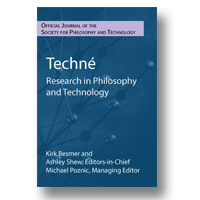|
articles |
|
1.
|
Techné: Research in Philosophy and Technology:
Volume >
28 >
Issue: 1
Luca M. Possati
Negotiating Actors:
ANT and Social Robotics
abstract |
view |
rights & permissions
| cited by
This paper intends to address social robotics from the Actor-network theory (ANT) perspective. Starting from the critique of Seibt’s approach and the distinction between anthropomorphing and sociomorphing, the paper proposes a new methodological approach based on ANT and negotiation concepts. This approach allows us to: a) assume a more symmetrical ontology in which robots are considered as social agents, like humans; b) consider all the interactional elements as of equal importance; and c) overcome the dualistic limit that is often imposed on social robotics studies, i.e., the tendency to consider only the one-to-one relationship, one man-one robot, inside the laboratory. Anthropomorphing and sociomorphing are the results of a negotiation process that cannot be reduced to a series of degrees of simulation, but must be understood as a complex interactional process between many agents and material mediations.
|
|
|
|
|
2.
|
Techné: Research in Philosophy and Technology:
Volume >
28 >
Issue: 1
Muriel Leuenberger
Technology, Personal Information, and Identity
abstract |
view |
rights & permissions
| cited by
Novel and emerging technologies can provide users with new kinds and unprecedented amounts of information about themselves, such as autobiographical information, neurodata, health information, or characteristics inferred from online behavior. Technology that provides extensive personal information (PI technology) can impact who we understand ourselves to be, how we constitute ourselves, and indeed who we are. This paper analyzes how PI technology’s external, quantified perspective on us affects identity based on a narrative identity theory. Disclosing the intimate relationship between PI technology and identity sheds light on a whole new range of ethical issues that have received insufficient attention so far. Personal information provided by technology is not just information that belongs to individuals but also changes them.
|
|
|
|
|
3.
|
Techné: Research in Philosophy and Technology:
Volume >
28 >
Issue: 1
Oliver Alexander Tafdrup
Ernst Cassirer and the Symbolic Mediation of Technological Artefacts:
An Addendum to the Vocabulary of Mediation Theory
abstract |
view |
rights & permissions
| cited by
The concept of mediation plays a central part in several positions of contemporary philosophy of technology. Especially Don Ihde and Peter-Paul Verbeek have served to establish mediation as one of the core concepts in the postphenomenologically rooted philosophical analysis of human-technology-world relations. While meditation theory provides many important conceptual and empirical contributions to our knowledge of how material artefacts shape our embodied being in the world, too little attention has arguably been given to the development of concepts that enable a philosophical analysis of the symbolic aspect of technological artefacts. This paper aims to develop the notion of ‘symbolic mediation’ by drawing on inspiration from the tradition of philosophical anthropology, more specifically, the work of Ernst Cassirer and his Philosophy of Symbolic Forms (PSF). Drawing on empirical examples of human-robot interactions (HRI), I coin two types of symbolic mediation: 1) mythic mediation and 2) aesthetic mediation.
|
|
|
|
|
4.
|
Techné: Research in Philosophy and Technology:
Volume >
28 >
Issue: 1
Cristian C. Vélez
Re-embodiments and Mind-Extensions:
Categorizing Cognitive Enhancement Cybernetic Technologies
abstract |
view |
rights & permissions
| cited by
Currently, humanity is experiencing an explosive growth in technological objects designed to improve the body and mind. The main objective of this article is to review two recent classificatory and explanatory systems to cognitive enhancement cybernetic technologies, including both wearable and implantable artifacts that reorganize human embodiment or extend the mind. I argue that an outdated model of the cognitive sciences serves as the basis for these revised systems and taxonomies. Taking an embodied approach to the cognitive sciences, I propose an alternative focus to classify cognitive enhancement cybernetic technologies. Specifically, by adopting a non-orthodox enactive approach to embodied cognition, I propose a new classificatory system that redefines the notion of the cybernetically enhanced human, restricting it to a purely cognitive context. Finally, I evaluate some philosophical implications of my system.
|
|
|
|
|
5.
|
Techné: Research in Philosophy and Technology:
Volume >
28 >
Issue: 1
Susan B. Levin
The Less Visible Side of Transhumanism Is Dangerously Un-radical
abstract |
view |
rights & permissions
| cited by
According to transhumanists who urge the radical enhancement of human beings, humanity’s top priority should be engineering “posthumans,” whose features would include agelessness. Increasingly, transhumanism is critiqued on foundational grounds rather than based largely on anticipated results of its implementation, such as rising social inequality. This expansion is crucial but insufficient because, despite its radical aim, transhumanism reflects beliefs and attitudes that are evident in the broader culture. With a focus on the yearning to eliminate aging, I consider four of these: a disproportionate reliance on science and technology to address major human challenges; the conceptualization of human beings in terms of binaries like “young-old”; a repudiation of vulnerability; and intensifying perfectionism. Illuminating these interlocked commitments both deepens an existing critique of transhumanism and draws our attention to deleterious cultural views that must be vigorously contested if our commitment to human flourishing is to be deep and unwavering.
|
|
|
|
|
book review |
|
6.
|
Techné: Research in Philosophy and Technology:
Volume >
28 >
Issue: 1
Alberto Romele
Mechanical Angels
view |
rights & permissions
| cited by
|
|
|
|





